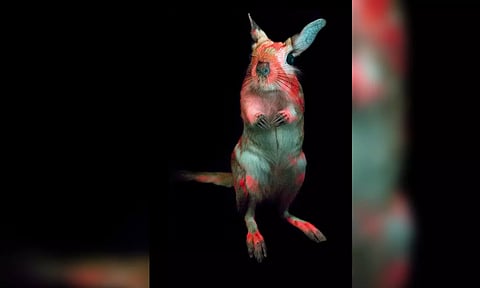

By Cara Giaimo
NEW YORK: At first, it seemed to be another caprice of two already unusual animals: Flying squirrels and platypuses were found to be fluorescent, absorbing invisible ultraviolet light and re-emitting it in shocking pink or bright cyan. But they are far from alone. According to a paper published in the journal Royal Society Open Science this month, lions, polar bears, scaly-tailed possums and American pikas also fluoresce. So does every mammal species a group of scientists could get their hands on.
While this large survey of museum specimens doesn’t reveal any broad evolutionary benefit, it overturns the view of mammal fluorescence as an occasional and mysterious quirk. Instead, it appears this trait is “basically the default,” said Kenny Travouillon, curator of mammalogy at the Western Australian Museum and the paper’s lead author.
While scientists have documented fluorescent mammals for over a century, there has been a flare-up of interest in the topic in the past several years. Researchers shining blacklights into backyards, forests and museum cabinets have come away with a crayon box of discoveries.
Most of the resulting studies focused on one species, or a few, “trying to better understand the nuances of the trait” in a single mammal type, said Erik Olson, an associate professor of natural resources at Northland College in Ashland, Wis., who helped to uncover fluorescence in flying squirrels, platypuses and springhares.
He was not involved in the new study, in which researchers investigated museum specimens of 125 species belonging to more than half of existing mammal families, from Antilocapridae (pronghorns) to Vespertilionidae (vesper bats).
They found some fluorescence in all of them. The survey “clearly establishes a broad distribution of the trait within mammals,” Dr. Olson said, “something I did not expect.”
Dr. Travouillon said the idea for this survey blinked on in 2020 when the platypus discovery spurred researchers at the Western Australian Museum to point a UV lamp at their own collections. They found turquoise-tinged wombats and bright-flanked flying foxes. But were these stuffed specimens really glowing? Or could something else, like preservatives or fungus, be to blame?
Joining up with colleagues from Curtin University in Perth, the team used a spectrophotometer to expose the specimens to UV light and analyze any emitted fluorescence. They also tested newly acquired specimens of several species — including a platypus, a koala and an echidna — before and after they were preserved.
Preservation with borax and arsenic affected the intensity of fluorescence, increasing it in certain cases while dampening it in others. But it never created fluorescence where there wasn’t any.
This before-and-after testing is “a great contribution to understanding the effects of museum preservation on fluorescence,” said Linda Reinhold, a zoologist at James Cook University in Australia who served as a peer reviewer of the study.